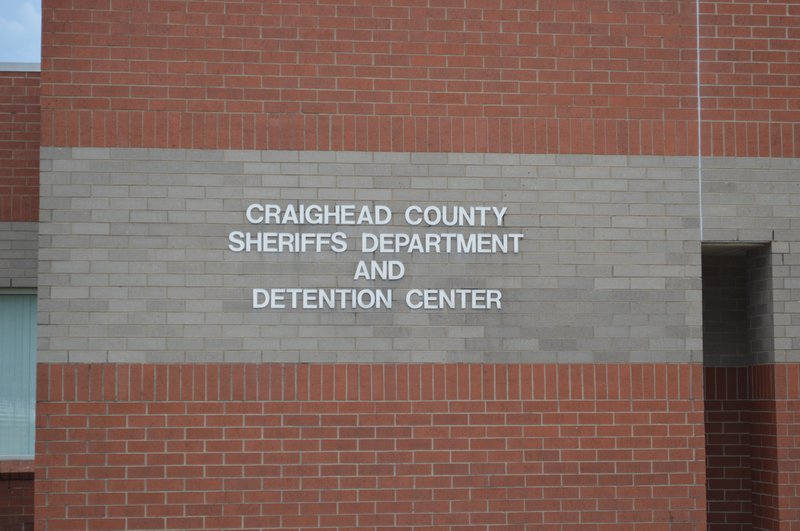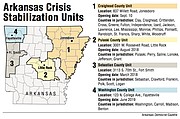A crisis stabilization unit opening this month in Craighead County will have only 16 beds, but officials say they believe that will be enough to serve the 20 counties in the unit's coverage region.
The Craighead County Crisis Stabilization Unit is expected to open by Sept. 10 and will sit next to the Craighead County jail. Mid-South Health Systems will operate the facility.
"It will be a first-come, first-served basis," Craighead County Sheriff Marty Boyd said. "Hopefully, we can start serving people right when the doors open."
Gov. Asa Hutchinson and the state Legislature approved Act 423 in 2017, opening the way for the establishment of four regional crisis units to provide services to people with mental-health problems who might be facing jail.
The Craighead County facility will be the last of the four units to open. Sebastian County's unit has been up and running for more than 17 months, and the Pulaski County unit marked its one-year anniversary in August. The Northwest Arkansas Regional unit opened June 28.
The Craighead County unit will serve 20 counties in northeastern Arkansas and surrounding areas: Clay, Craighead, Crittenden, Cross, Greene, Fulton, Independence, Izard, Jackson, Lawrence, Lee, Mississippi, Monroe, Phillips, Poinsett, Randolph, St. Francis, Sharp, White and Woodruff.
"Initially there were 13 counties, but it made sense to include the additional seven counties that Mid-South Health now covers," said Kathryn Lawson Griffin, justice reinvestment coordinator with the governor's office.
MEDICAID RESTRICTIONS
Boyd said officials capped the number of beds available for patients at 16 because of Medicaid restrictions.
"From what I understand, if we went over 16 beds then it would fall under hospital guidelines, which would have different mandates and be more expensive," the sheriff said.
Dr. Lisa Evans, assistant professor with the psychiatry department at the University of Arkansas for Medical Sciences and director of the Pulaski County Regional Crisis Stabilization program, said capping the number of available beds at 16 allows Medicaid to prevent the warehousing of patients.
Boyd said he isn't too concerned about the limited number of beds being an issue.
"Some of the counties we are supposed to serve are so far out that I don't see them using the facility," Boyd said.
Griffin said so far the data backs up Boyd's belief.
"Being too full would be a wonderful problem," she said. "Every unit thinks they will be full when they open, but that isn't usually what happens.
"From what we have seen, if it [is] less than a 30-minute drive then you won't think twice about using the facility, but if it's longer, then they will have to think [about] if it's worth it. I think some of the areas in Craighead County will be almost two hours away."
TELEMEDICINE TRIAGE
Typically the host county uses the facility the most. The central Arkansas unit serves six counties, but Evans said most of its patients are from Pulaski County.
"Once you get to, say, Jefferson County and beyond the transportation becomes an issue," she said.
Joey Potts, director of Sebastian County's Five West Crisis Stabilization Unit, said the majority of that unit's admissions are from Sebastian County with a few from Franklin and Logan counties, but they also have found a way to assist some of the more rural areas in the coverage region.
"We are using a new mobile triage system where we are able to utilize telemedicine," said Rusti Holwick, CEO of the Western Arkansas Counseling and Guidance Center. "Rather than making them come all the way to us, we can do a triage screening over the phone and determine if they would be admitted to the facility and diagnose the situation.
Griffin said officials want the units to take advantage of telemedicine.
"We built the telemedicine into the budget, actually," she said. "It's very advantageous. It can also help an office to decide if a person they are with is an appropriate candidate for referral."
The state earmarked about $6.4 million for operating costs for the program, about $1.4 million for each of the four units. Another unit would have to be built if there is a need for more beds, but so far the data haven't shown the need for additional units.
The goal for the crisis stabilization units is for each facility to see an average of 100 clients a month, or 1,200 a year.
"I met with the governor [on Wednesday] and he is very happy with the progress that the three [crisis units] that are open have made," Griffin said. "Sebastian County helped 869 clients in its first full year."
The Sebastian County unit was the first unit to open and is run by Western Arkansas Counseling and Guidance Center. Since it opened in 2018, the center has had 2,043 referrals and 1,297 assessments that resulted in treatment, Holwick said.
"In the beginning the numbers were pretty low, but now we see roughly 80 to 90 admissions a month," she said.
The Pulaski County crisis stabilization unit, staffed by UAMS, was the state's first nationally accredited unit and the first UAMS program to be accredited by the Commission on Accreditation of Rehabilitation Facilities International, a nonprofit accreditor of health and human services that assists providers with improving the quality of their services.
The 16-bed unit has had 500 admissions since opening last year.
"Every month we get more referrals," Evans said. "We are averaging 70 this month, and it's climbing every month."
Attempts to contact the Northwestern Arkansas unit by phone were unsuccessful.
QUICK TURNAROUND
Evans said the units are designed to stabilize patients quickly and get them out in less than three days.
"We do a quick triage, as we are a primarily behavioral health service, then through a diagnostic setup we will get them the medications they need quickly and detox if necessary," she said. "At the start of day one we are planning for discharge."
Everyone taken to the unit leaves with an appointment to see whatever medical professional is needed.
"We will follow up with them in 30 to 60 days to see how they are doing," Evans said. "We are in constant communication with police, city and county officials to continue to create a healthy relationship to make this successful."
Griffin said she hopes to see Pulaski and Washington counties eventually average 100 clients, but law enforcement agencies will have to get involved to reach that goal.
"The biggest problem has been law enforcement buy-in,"Griffin said. "Some counties are all for it, and some are slow to utilize it."
The fee to use the facility also has been an issue for some counties, she said.
"Some of these cities or counties hadn't budgeted for the fee," Griffin said. "The host counties decided to just waive the fee for the year. This allows them to get used to using the facility and shows the benefits of using the facility, so when the fee comes back around they know it's worth it.
The state will use data gathered over the next few years to see if the units are having the intended impact.
"We have narrowed in on a cohort population and we have identified them as people who have highly utilized law enforcement and emergency personnel," Griffin said. "We will see if they are reducing the burden on those departments."
The crisis units are a pilot program that, if successful, could increase the number of facilities across the state, Griffin said.
"If the numbers show that it's worth it, then we can make sure every county in the state has access to one, and that will mean building more units," she said.
Griffin said officials are optimistic the data will show the units are helping people in mental crisis and are diverting them from jail, while also keeping communities safer.
"We really want to see the cycle broken," she said. "If we can end the cycle of being in and out of jail and emergency departments, then we can help our jails, keep our community safer and reunite families."
State Desk on 09/01/2019

